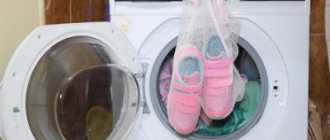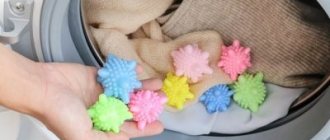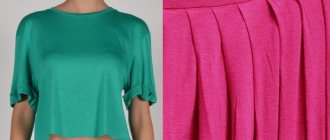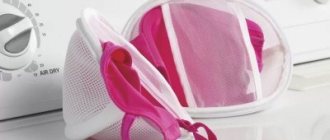A bag for washing clothes in a washing machine has only recently begun to gain popularity, given that it has been around as an assistant for caring for clothes for quite some time. First of all, it performs a protective function - it protects fabrics from mechanical damage during washing, minimizing the contact of textiles with the centrifuge. But, besides this, it has many more advantages.
Why are laundry bags needed?
In washing machines, things can be washed without bags, simply by placing them in the drum. But this is not always worth doing. Washing machines have always had a drawback - they can return clothes somewhat damaged. After spinning hundreds of times in the washing machine, many things lose their original appearance. By putting them in a durable bag, the user receives a lot of benefits:
- Things don't stretch out or lose their shape. This is especially important for knitted and thin fabrics, lace, tulle curtains, and knitted items.
- You don’t have to look for small things, collecting them on the drum.
- There are special bags: for underwear and socks, sportswear, textile shoes and sneakers.
- It happens that small things stick to the glass and cling to the rubber seal. Having a special case, you can get everything out of the machine in bulk, without missing anything.
- Taking good care of wardrobe items loaded into the drum of the machine allows you to save money on buying new clothes to replace those that have become unusable ahead of time.
- The drum is not damaged. There may be hard particles in the pockets that can scratch it when the drum rotates. Large objects can cause more serious damage and damage any parts of the device. This also applies to metal fittings. Not a single bead will fall out of the case.
Today, clothes are often decorated with decor - embroidery, rhinestones, sequins, beads. After a long rotation in the drum, all this beauty can come off, the clothes lose their attractiveness, and you have to either sew on the lost decor or write off the T-shirts and sweaters for home use. Previously, many items made from delicate fabrics were washed by hand - it was better to work with your hands than to lose a beautiful blouse or airy dress. Today, thanks to special containers, most items can be protected from the side effects of machine washing.
What is washed in bags?
- Lingerie. Bags allow you to preserve the attractive appearance and integrity of lace panties and bras, and other delicate items of women's wardrobe. Lingerie for women is not cheap. There are also expensive handmade models among them. Having special covers, you don’t have to risk the integrity of expensive bras, panties, handkerchiefs and other small items.
- Tights. This item of women's wardrobe is especially vulnerable. Washing them without a bag is more expensive for yourself. They like to cling to other things, so after the machine they tear and become unusable.
- Knitwear and knitted items. Thanks to this useful device, they do not stretch or lose their shape, and their fibers are not damaged.
- Jackets and down jackets. When washing jackets, problems may arise due to the numerous hard fittings - there may be locks, buttons, buttons, or other accessories that are dangerous to the integrity of the surface of the drum.
- Shoes. The mesh will protect the machine from hard parts and from the shoes themselves, which can also be quite hard.
Why is it better to wash bags by hand rather than in a washing machine?
Cellophane, plastic and polyethylene that go into the bag are thermally unstable. Hot water deforms them, cellophane becomes toxic when heated. In addition, paint comes off easily from plastic, and after machine or rough hand washing, the bags “peel off” and lose their attractiveness.
How to wash bags
If you still have a lot of bags and need to wash them, consider the following recommendations:
- When washing by hand, soak the bags in a basin so that they are not crowded. Do not rub, but swirl the water, do not forget to turn each one out to better clean the inside. If you need to clean heavy stains, use a soft sponge. Change the water often.
- When machine washing, load the drum only halfway and set a gentle mode, for example, the “Wool” or “Sport” program, and turn off the spin cycle.
What are they?
Criterias of choice
The bags offered on the market may vary:
- shape;
- sizes;
- lock type;
- material.
When choosing an option, you need to consider: what are the bags for? They vary depending on the purpose. So, a cover designed for a down jacket will not be suitable for shoes or bras.
Material of manufacture
The most common materials are polyester and nylon. They withstand high temperatures, do not shrink and are not deformed. These synthetic materials are wear-resistant, environmentally friendly and durable. Nylon can be reused many times without any damage to its properties and integrity. The material may have a different structure. There are bags:
- solid - with a dense structure;
- fine-mesh - mesh.
The shape is as simple as possible, not interfering with rotation, rinsing and spinning. Containers are:
- cubic;
- square;
- spherical;
- round;
- cylindrical;
- rectangular;
- prismatic.
Purpose
To ensure comfortable conditions for all things, it is advisable to stock up on different types of covers - for shoes, underwear, bras. The latter, for example, to create the most delicate regime, are equipped with plastic “ribs” that guarantee the preservation of quality and shape. Such covers provide reliable protection for delicate fabrics and handmade items.
Dimensions and type of lock
When choosing an option, you need to consider the size and volume of things. Obviously, oversized jackets and all small linen items require covers of different capacities. To prevent things from falling out during rotation in the machine, the bags are equipped with:
- lightning;
- laces.
Kinds
There are a lot of different covers for linen on sale; you can navigate this variety using several parameters:
- Quality of material. Laundry bags are made from synthetic fabrics that are resistant to moisture, dirt, and chemical influences. Polyester or nylon is used in production. Both materials have similar characteristics. Nylon is softer and is often used in smaller lingerie styles.
- Fabric structure. The bags can be mesh or made of porous fabric with holes. The larger the cells, the better the penetration of water. The smaller the holes, the more carefully the fabrics are washed.
- Form. The nets can be flat envelopes, bulk bags or containers with a fixed shape: cylindrical, spherical, cubic. Frame models are plastic and retain volume with the help of special elastic inserts.
- Size. Washing cases can be of different sizes: from compact models for one bra to large ones for a coat or down jacket. Capacity is determined by the length and width of the bag, marked on the packaging. For large nets, indicate the amount of laundry loaded in kilograms.
- The type of things that need cleaning. There are separate models for bras, frame nets for shoes (including sneakers), loose bags for laundry or curtains. Each type of cover is effective if used as intended.
You should choose laundry bags on sale based on the price-quality ratio. Such a product is not an expensive one, and its high cost for some brands is not justified by anything other than a big name.
In the middle price category, you can choose a bag of the optimal size or buy several pieces at once in a set. Inexpensive nets serve well for washing for several years.
Laundry bag overview
Top house
Heat-resistant mesh bag made in Germany. Prevents small objects from getting into the internal elements of the washing machine. During development and manufacturing, the recommendations of leading washing machine manufacturers were taken into account. Designed for knitwear, tulle, curtains.
| Dimensions, cm | 50Х70 |
| Designed for weight, kg | 3 |
| Form | rectangular |
| In packaging, pcs. | 1 |
| Temperature (min/max), °C | 0/90 |
| Cost, rubles | 499 |
Top house products are described as reliable and high-quality products that will last for years. Users advise purchasing several pieces at a time - they wear out in about six months if washed 1-2 times a week. Consumers have several bags for different things. In one they wash, for example, children's clothes, in the other - underwear, and so on. German products have earned a lot of positive reviews: they are incomparably stronger and more reliable than their cheap Chinese counterparts.
Bra Baby
Container for bras. Designed for delicate washing of bras.
| Diameter, mm | 150/120 |
| Temperature (min/max), °C | 0/90 |
| Cost, rubles | 189 |
Most women did not appreciate Chinese products. Users are unhappy with bra containers made in China. Reviews from women are clear - this is an inconvenient and low-quality container that spoils the shape of bras and twists their straps.
STORIE D'AMORE (Faberlic)
The bra container from . Women are extremely pleased with the quality of this product. Its cost is about 200 rubles. With it you don’t have to worry about dropped “bones”.
Brabantia
White bags from a Belgian manufacturer. Designed for underwear. The set includes one large mesh case and two small mesh bags. Fastened with a zipper. The lock has a tongue pad that prevents damage to the drum walls. The manufacturer provides a two-year warranty.
| Dimensions large/small, cm | 45x33/33x25 |
| Temperature (min/max), °C | 0/90 |
| In packaging, pcs. | 3 |
| Cost, rubles | 799 |
It’s not for nothing that the manufacturer gives a two-year guarantee; reviews indicate that these are truly high-quality products that preserve the beauty and integrity of things. Women note that Brabantia mesh is great for bras and other underwear.
PARODI&PARODI
Products from an Italian manufacturer. Users have not yet had time to evaluate it, so it is difficult to judge the quality of these small products. Suitable for wool and other delicate items. You can wring out and dry in them.
| Dimensions, cm | 30x40 |
| Temperature (min/max), °C | 0/90 |
| Cost, rubles | 199 |
Whitening Tips
Methods for bleaching bras depend on the composition of the product. Modern models are often made from artificial materials, which can be conveniently bleached with synthetic bleaches. To choose the right product, you must read the manufacturer's instructions. If the composition is intended for delicate fabrics, it will not ruin your favorite linen. It is better to give preference to oxygen-containing agents, as they are less dangerous to fabric fibers.
The bra should be soaked in water at room temperature, following the proportions specified by the manufacturer. It is not recommended to keep laundry in the solution for more than 2 hours, as this can damage the delicate fabric.
Baking soda will also help make your bra white. To do this, dilute it in water at the rate of 1 tablespoon per liter. The product is immersed in this solution for 2 hours, then rinsed thoroughly.
Bleaching with boiling is only possible for cotton products without synthetic inserts. But when boiling, you can get by with the simplest means:
- The bottom of the basin or pan is covered with a white cloth;
- Add grated laundry soap into the water and stir lightly;
- load the bra into the container and boil for 30 minutes with regular stirring;
- The boiled item is rinsed in cold water.
To ensure that your bra retains its shape for a long time, you should take care of it from the moment of purchase. You should not sleep in it - it is harmful for both the woman and the bra. It needs to be changed often enough so that it can “rest.” And bleaching should not be put off for long: the dirtier the product, the more difficult it is to restore its original color.
How to use?
- Don't stuff them too full, otherwise things won't stretch well. Approximately 1/3 of the volume should be left free.
- Several nets can be placed in the drum at the same time, the main thing is that the weight does not exceed the permissible load.
- You can’t put powder in bags - this also happens. Detergent should only be poured into special trays.
- Locks should be closed tightly so that they do not come unfastened or come undone if they are laces.
Where to buy a useful device? In specialized stores or online stores. This is an affordable product available in a wide range.
Pouch for carrying tights
It never hurts to carry spare tights or stockings with you.
But branded cardboard packaging takes up too much space in a lady's handbag. And even the boxes in which some manufacturers pack their tights so that you can always carry a “spare” with you are inconvenient: they tear quickly. If you take the tights out of the cardboard packaging, leaving them only in the plastic case, then, firstly, they will quickly come out of it, and secondly, the polyethylene rustles. Tights bags are designed specifically to give you somewhere to put spare tights. The amorphous pouch takes up minimal space in your bag and does not cause any inconvenience. Ribbon ties, elastic bands or ties prevent the tights from getting out and tangling everything in the bag. In a word, a fabric bag is a kind of organizer for tights.
Bag for tights
How to sew it yourself?
How to replace an expensive device? Many housewives prefer to sew covers themselves. It costs less, and if the work is done well, the products can last much longer than their industrial counterparts. Especially when it comes to cheap Chinese products. For sewing you will need:
- old tulle curtains;
- hidden zipper 50 cm;
- sewing machine;
- scissors and ruler;
- colored chalk;
- white threads.
The sizes can be any, you can sew several options - for large and small loads. You can focus on the sizes used by manufacturers - 30x40, 50x70, 150x120 cm. Take the average size first - 60x60 cm. If you lay out the pattern, you will get a rectangle of 120x60 cm. How to sew the case itself, the procedure:
- The fabric is laid out. The zipper is pinned at one end with pins. The clasp should be positioned in the center.
- Attach a zipper.
- Fold the fabric so that the opposite edge covers the second part of the zipper. The clasp is unfastened and stitched.
- The areas that were not covered by lightning are sewn in advance on both sides.
- The result is a zipper sewn along a closed ring.
- There are only minor things left - you need to sew up the holes on the side. To do this, the ring is turned inside out so that the clasp is turned inside out.
Instructions
Place the smaller rectangle on top of the larger one, secure with pins, and stitch at a distance of 0.5 cm from the edge.
Lay the fabric on the ironing board and iron the seam allowance to one side. Topstitch it, departing from the first seam by 0.4 cm.
Repeat for the remaining parts.
Fold the resulting rectangles wrong sides together, aligning the horizontal seams. Sew around the perimeter, retreating 0.5 cm from the edge. Do not sew one short side (in our example, the black side).
Turn the bag inside out, straighten it carefully and stitch again along the same three sides, retreating 0.6 cm. Fasten and cut the threads.











